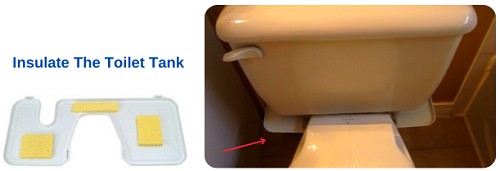You might have noticed your toilet tank cover sweating, especially on warm days. Don’t get alarmed because this doesn’t mean that your commode is malfunctioning. Toilet tank condensation is only a result of your bathroom environment.
Condensation occurs when the toilet tank is colder than the air inside the bathroom. Water droplets form when the humid air gets in contact with the cold toilet tank surface. A few solutions include installing a mixing valve, insulation liners, and an exhaust fan.
Learn more about the causes, preventions, and solutions for toilet tank sweating.
Table of Contents
Why is my Toilet Sweating?
High humidity could be the main culprit for why your toilet tank is sweating. When the moist or humid air touches the cold surface of the tank, tiny droplets of water form like what you see outside of a cold soda can.
The moisture doesn’t evaporate due to lack of ventilation, hence, making the toilet tank look sweaty.
Condensation under toilet bowl and tank isn’t a serious problem, but it can cause damage to other fixtures when left unsolved. The water dripping from the toilet can discolor the floor and the wall on the back of the toilet over time.
Prevention and Solutions
Thankfully, there are easy ways to solve and prevent toilet tank condensation. Let’s discuss each one below.
Tip #1: Take Cool Showers
If you’re having a condensation problem, it’s unwise to make matters worse with a hot shower. A simple way to stop toilet tank from sweating is to take cool showers on a sweltering, humid day.
Using a cool shower can help reduce indoor temperatures significantly. When the temperature is lower, there’s less chance of moisture forming in the air.
Tip #2: Install an Exhaust Fan
If you’re a fan of hot showers, putting an exhaust fan in the bathroom is a more practical sweating toilet tank remedy. The exhaust fan will carry the water vapor and heat to the outside of your bathroom. Remember to leave the windows open with the exhaust fan running after taking the hot shower to increase air circulation.
Look for an exhaust fan with an accurate humidity sensor to turn the unit on automatically. To ensure maximum performance, choose a model with a high CFM rating. The rule of thumb is to add 1 CFM for every square foot of your bathroom size.
If you end up with a less powerful exhaust fan, let it run for a few extra minutes after taking a shower to remove all the moisture in the air.
Tip #3: Use an Air Conditioner or Dehumidifier.
Opening the windows on a hot day can only make the humidity worse inside your bathroom. The best way to deal with a toilet sweating in summer is to install an air conditioner. The air conditioner collects and drains the condensation in the air to reduce humidity while keeping you feel cool.
In winter, you can use a dehumidifier to dry out your toilet. These units keep the toilet from sweating without dropping the temperature in the bathroom.
Many recent air conditioners already include a dehumidifying function to offer versatility. These models are excellent options to avoid purchasing separate devices to reduce humidity.
Tip #4: Avoid Flushing the Toilet After a Shower
Another easy sweaty toilet tank fix is to refrain from flushing the commode right after you shower. Moisture is more abundant after you use the bathroom, so wait for the air to dry out before you start filling the tank with cold water.
You don’t want the moist air to get in contact with the cold tank, or else condensation will occur.
Tip #5: Install an Anti Sweat Valve or Mixing Valve
Since the cold water inside the tank can cause toilet bowl sweating, try to bring the temperature in it closer to the temperature inside the bathroom. Install a mixing valve to increase the tank temperature.
It’s best to choose an adjustable mixing valve to get more precise heat control. To install this product, simply position the valve between the cold water line and hot water line of your toilet’s plumbing system. Ask a professional plumber to do the installation because it needs great accuracy.
Tip #6: Insulate the Toilet Tank
You can also keep the tank at a comfortable temperature with a bit of insulation to prevent condensation.
Purchase a toilet tank insulation kit, which includes a toilet tank liner made of foam. These liners often come with an adhesive back, making them easy to install.
A cheaper alternative is to use bubble wrap to insulate the tank. If you have an old tank that needs replacement, get an insulated toilet tank that’s compatible with your current bowl.
Tip #7: Get a Drip Tray or Drip Catcher
If you notice water dripping from your toilet, it would take time to get the desired result with the solutions above. A quick solution is to put a drip catcher under the fixture. The tray will catch all the water and prevent your floor from getting ugly puddles.
Keep in mind that a drip catcher will only keep the moisture off your floor and not solve the condensation problem. Also, check the tray frequently to keep it from overflowing on the floor.
Conclusion
At this point, I hope you know why toilet tank condensation occurs and how to prevent or solve this problem. It’s all about keeping the temperature similar inside and outside the tank. My favorite solutions are to insulate the tank or use a dehumidifier to suck up all the humidity.
How about you? Tell us your experiences with toilet tank sweating in the comment section below. If you like this article, please share it with your friends.

Hello, my name is Freddie, and I am the founder of Saveourwaterrebates.com. I am inclined to launch this website in order to provide the best tips and guides for you to fix simple issues at home when access to a plumber is unavailable.
Over the course of my more than 15 years as a plumber, I’ve seen many families struggle with the simplest yet troublesome issues. It entails choosing the best appliances that will benefit them in the long run, as well as installing and maintaining toilet accessories and dealing with other sewage-related problems that arise.









